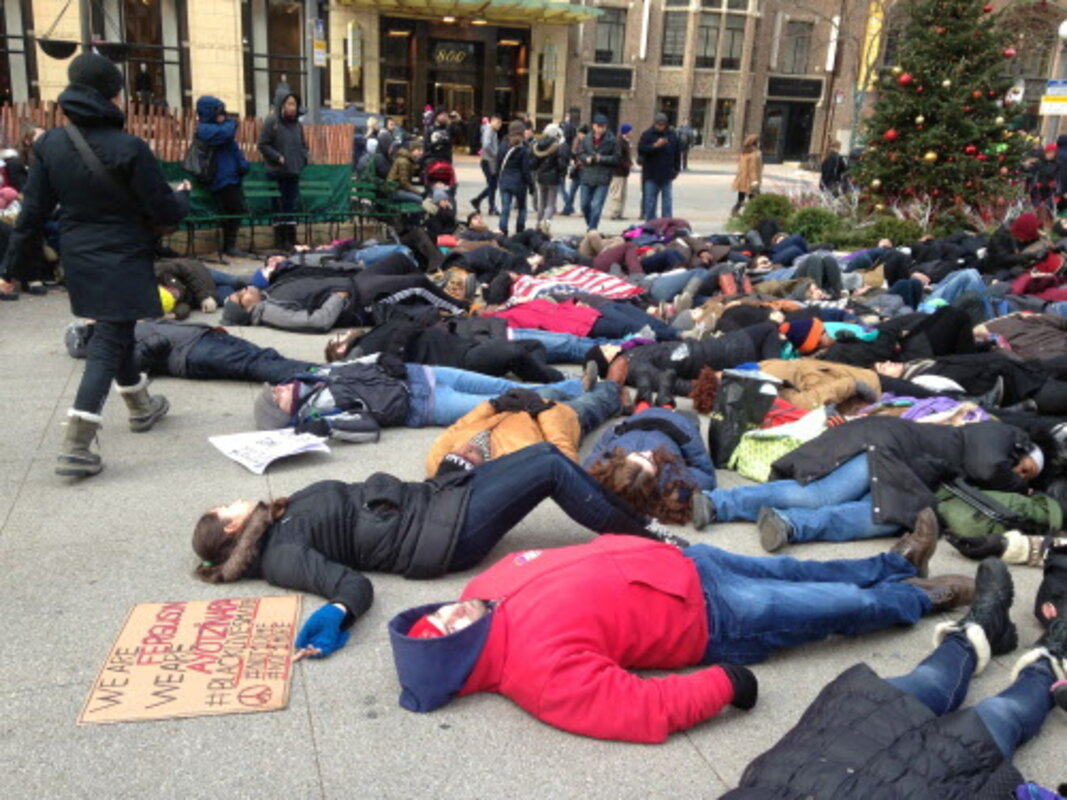Evidence of 'stingray' phone surveillance by police mounts in Chicago
Loading...
| Chicago
At a protest on Black Friday in Chicago over the Ferguson grand jury decision, rumors began circulating among the crowd that police were tracking organizer Kristiana Rae Colón’s iPhone.
Many of the protesters believed that the Chicago Police Department were using a so-called "stingray" tracker, a box-shaped device that can be used to monitor mobile phone activity and locations. Law enforcement around the country has been using the technology with growing frequency, often without a warrant.
In another part of Chicago, at the same time as the protest, ,��an account that live-tweets the police scanner,�� another officer if he was gathering information from the protest organizer’s phone.
“She’s been on her phone a lot ... you guys picking up any information where they’re going, possibly,” said an unidentified officer in a recording ��to the Web��by an activist group called Crime is Down. “Yeah, we’re keeping an eye on it,” said the other officer. “We’ll let you know if we hear anything.”
The recording is a “smoking gun," says Matt Topic, a lawyer suing the city of Chicago for refusing to disclose information about its use of stingrays.
The lawsuits are intended to prove that “stingray use has no oversight,” says Freddy Martinez, a privacy advocate who Mr. Topic is representing in two cases against Chicago. The suits are over Chicago's refusal to comply with Mr. Martinez's requests under the Freedom of Information Act for information about deploying stingrays.
If stingrays are used at all, says Mr. Martinez, the technology should be treated “how wiretaps are handled.” That means police departments would need to request a warrant for its use, the same way that law enforcements officials need a judge to approve tapping phone lines for the purposes of criminal investigations.
In his FOIA requests, Martinez asked the Chicago Police Department to provide information about its purchase of stingray technology and documentation about its use. If the technology is being deployed, he also wants to know what the department does with the data collected by stingrays.��
The CPD did not respond to a request for comment.��
Activists seek answers��
As evidence mounts around the country of law enforcement’s increasing usage of stingrays, activists and civil liberties groups are growing more concerned that they are being monitored and tracked. These concerns have intensified over the past few weeks as anti-police violence protests have erupted in major cities from California to New York.
Stingrays, or more technically known as International Mobile Subscriber Identity (IMSI) catchers, have been around since the 1990s. They work by mimicking a cellphone tower, coaxing wireless devices in the area to connect to it as the closest option. From there, the stingray has access to all kinds of data on a phone, from the location to phone and text logs. Until 2006, stingrays were used mostly in the war on terrorism. That is when police departments began acquiring them with grants from the US Department of Homeland Security.
Police departments generally refuse to acknowledge they possess this type of technology, or say that disclosing any real information about their use would hinder counter-terrorism efforts. Even if they wanted to, Nathan Freed Wessler, an attorney at the American Civil Liberties Union, says there may be a fiscal incentive to keep their use under “excessive secrecy.” Manufacturers such as Harris Corp., the largest distributor of stingrays in the US, ask police departments to sign a nondisclosure agreement.��
In Chicago, if Ms. Colón was in fact the target of the surveillance mentioned in the police recording, she's not surprised. “When the movement is responding to an unjust system, it is delusional to expect the system to respond to protests in a fair and just way,” she says.
As the organizer of the Chicago protest, Colón spent a lot of time on her phone because she was updating her social media profiles “as much as I could.” She posted pictures and status updates “[letting] people know we were marching toward Wicker Park.”
“I just assume in the iPhone and Snowden era, they can monitor anything,” says Colón.
Tracking the trackers
The details of when, how, and where police departments deploy stingray technology is typically a mystery to any outsider, but groups such as the ACLU are trying to uncover those details.
“We know there are 47 agencies across 19 states that bought their own, but there is an unknown number of departments borrowing from other agencies," says Mr. Wessler.
As for how often they’re used, the ACLU has a very limited picture that's beginning to become clearer.��The ACLU has identified 47 agencies in 19 states��and the District of Columbia��that own stingrays.
In Tallahassee, Fla., the ACLU determined through public records requests that police deployed stingrays more than 250 times between 2007 and 2014. It said that the Los Angeles Police Department��used stingrays at least 340 times in 2011. In Tacoma, Wash., the News Tribune����that police there��used them 179 times between 2009 and 2014.��The Charlotte Observer recently����that police officials there used stingrays more than 500 times in a five to seven year span.
In Charlotte, the police have reportedly obtained court orders, but not warrants, when it intends to track cellphone use with a stingray, according to Wessler.��The Charlotte Police Department, who did not respond to a request for comment,��has been requesting orders under the state pen register statute and the federal Stored Communications Act, instead of under the state statute governing search warrants.
A pen register is when police ask a telecommunications company to log the phone numbers that are dialed on a suspect’s device. But stingrays can reveal much more information since it allows uses to search through a phone, examine text logs, GPS locations��and data for others in the vicinity of the surveillance target.��
The Electronic Frontier Foundation, a digital rights group, calls stingrays an “unconstitutional, all-you-can-eat data buffet.”
According to the ACLU's Wessler, the warrantless use of stingrays is a violation of the fourth amendment. The stingray is indiscriminate, he says, as it “goes through walls, into homes, and private spaces.”
So far, few courts have weighed in on stingray usage. This October, Florida’s Supreme Court ruled using stingrays without a warrant is unconstitutional. State courts in Massachusetts and New Jersey made similar rulings.
But courts in other parts of the country see it differently.
In Arizona last week, the Prima Country Superior Court ruled the Tucson police department is not obligated to comply with public records requests on stingrays made by the media. Doing so "would give criminals a road map for how to defeat the device, which is used not only by Tucson but other local and national police agencies," said judge Douglas Metcalf.
��





